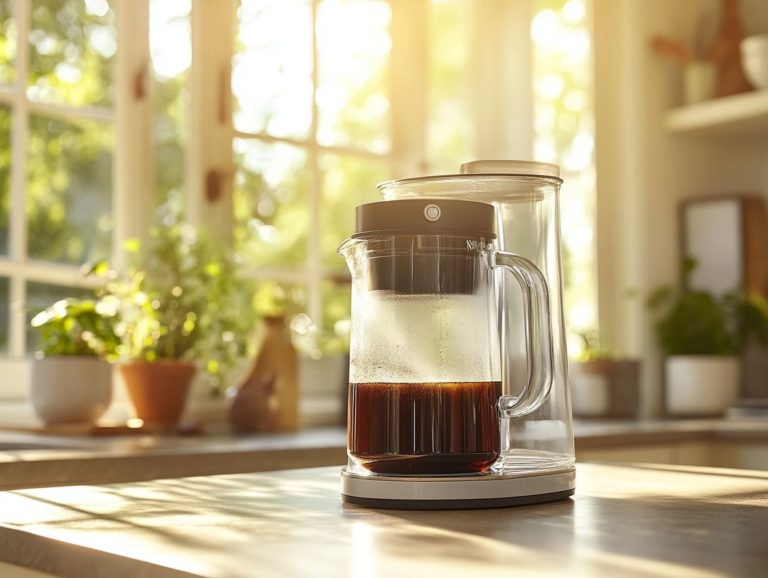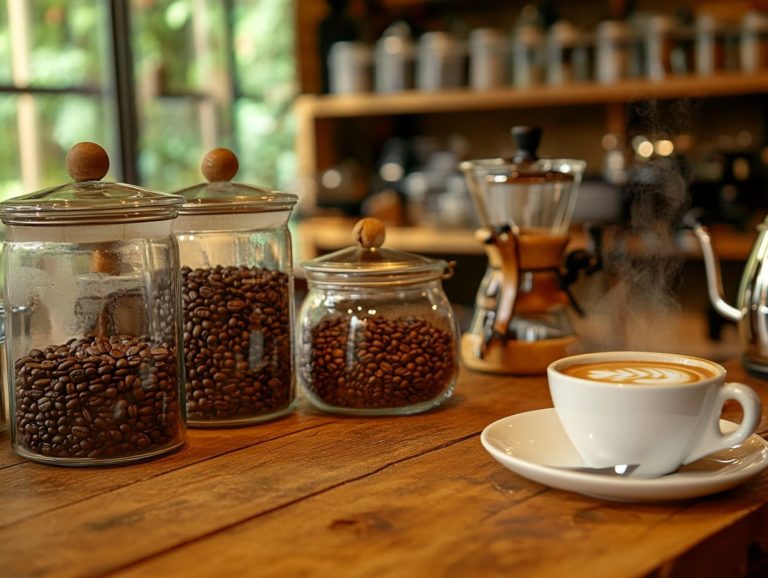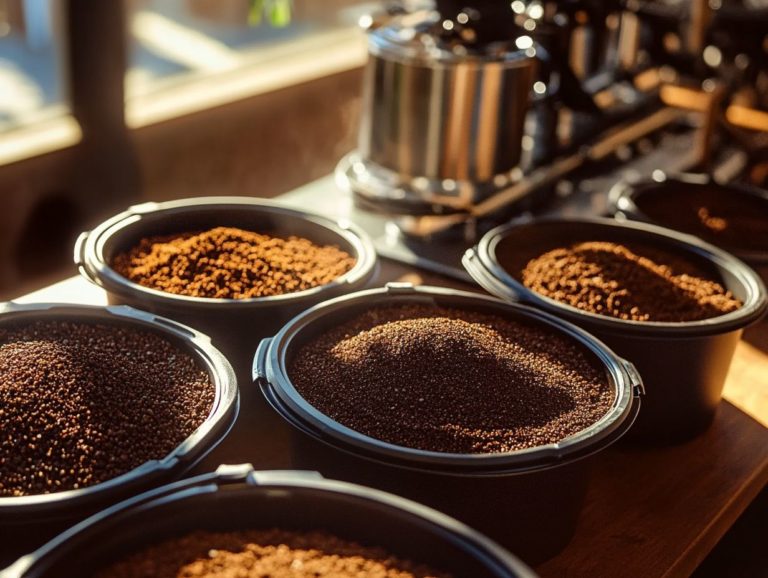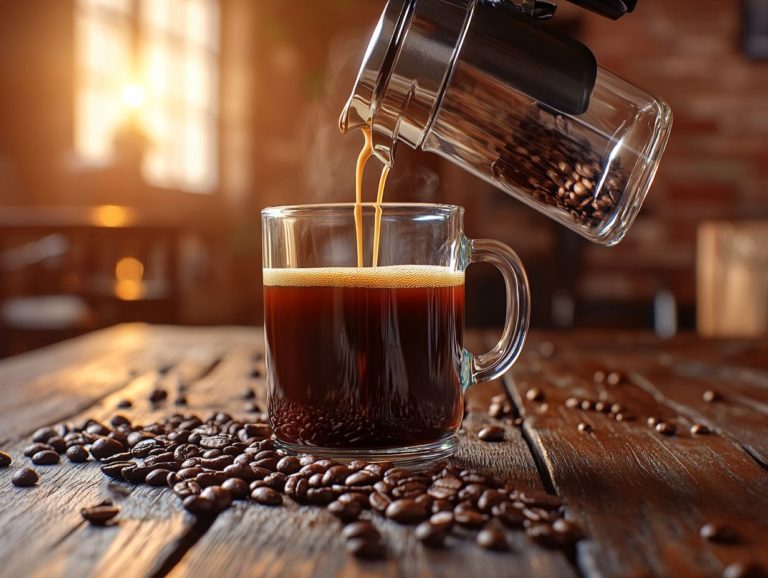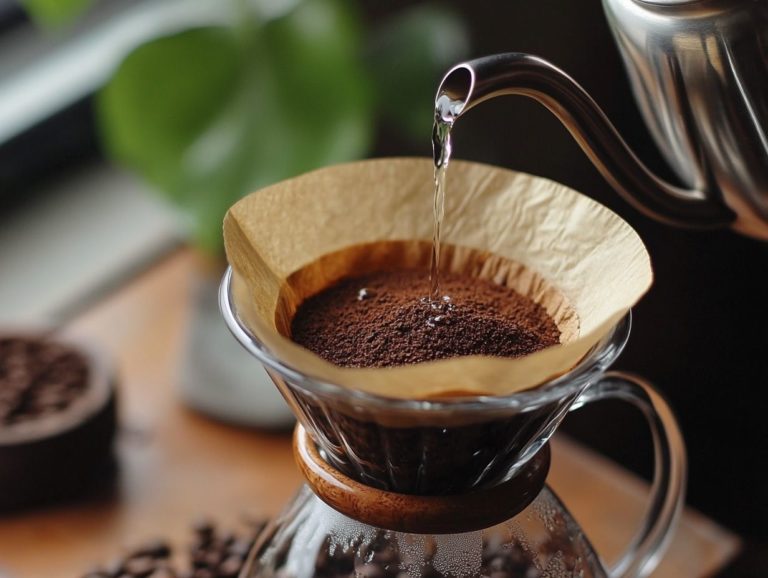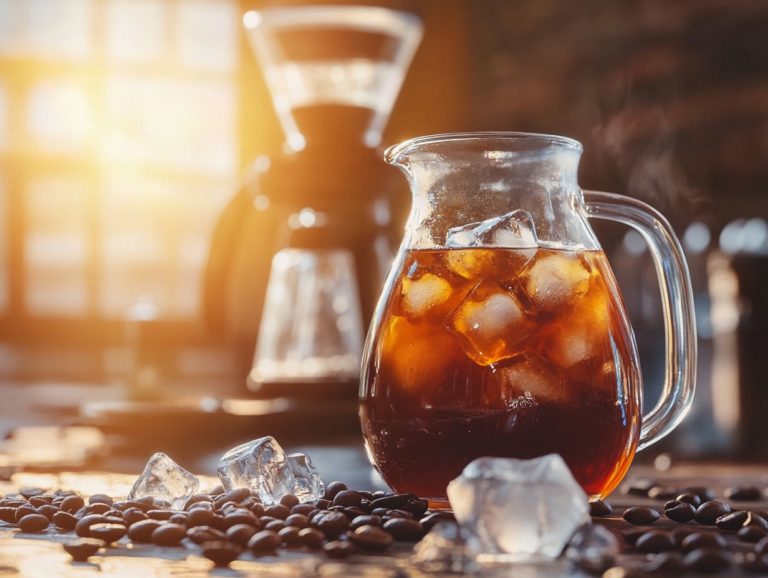Top Brewing Techniques for Specialty Coffee
Contents
- Introduction
- Key Takeaways:
- 1. Properly Measuring Coffee and Water
- 2. Choosing the Right Grind Size
- 3. Using the Correct Water Temperature
- 4. Mastering the Pour-Over Method
- 5. Understanding the Importance of Bloom
- 6. Perfecting the French Press Technique
- 7. Utilizing the AeroPress for a Stronger Brew
- 8. Cold Brewing for a Refreshing Cup
- 9. Using the Chemex for a Clean and Balanced Flavor
- 10. Experimenting with Different Brewing Methods
- What Is Specialty Coffee and Why Is Brewing Technique Important?
- How Can One Improve Their Brewing Technique?
- What Are the Latest Trends in Specialty Coffee Brewing?
- Frequently Asked Questions
- What Should You Keep in Mind When Brewing Specialty Coffee?
- Why Is Water Temperature Important in Brewing Specialty Coffee?
- How Does Grind Size Affect the Taste of Specialty Coffee?
- What Is the Ideal Coffee-to-Water Ratio for Brewing Specialty Coffee?
- How Can I Improve the Water Quality for Brewing Specialty Coffee?
- Are There Any Specific Brewing Techniques for Different Types of Specialty Coffee?
Introduction
Brewing the perfect cup of specialty coffee is truly an art, blending precision, technique, and a hint of your own personal flair that coffee enthusiasts worldwide appreciate.
This guide delves into the essential brewing techniques that can elevate your coffee experience, covering everything from accurately measuring coffee and water to mastering the subtleties of various methods like pour-over, French press, AeroPress, Moka pot, and cold brew.
Whether you consider yourself a seasoned barista or simply a casual coffee enthusiast, grasping these techniques will empower you to unlock the full potential of your favorite beans, ensuring consistency and precision in every cup.
Uncover the secrets to brewing exceptional coffee, enhancing your coffee journey from bean to cup!
Key Takeaways:
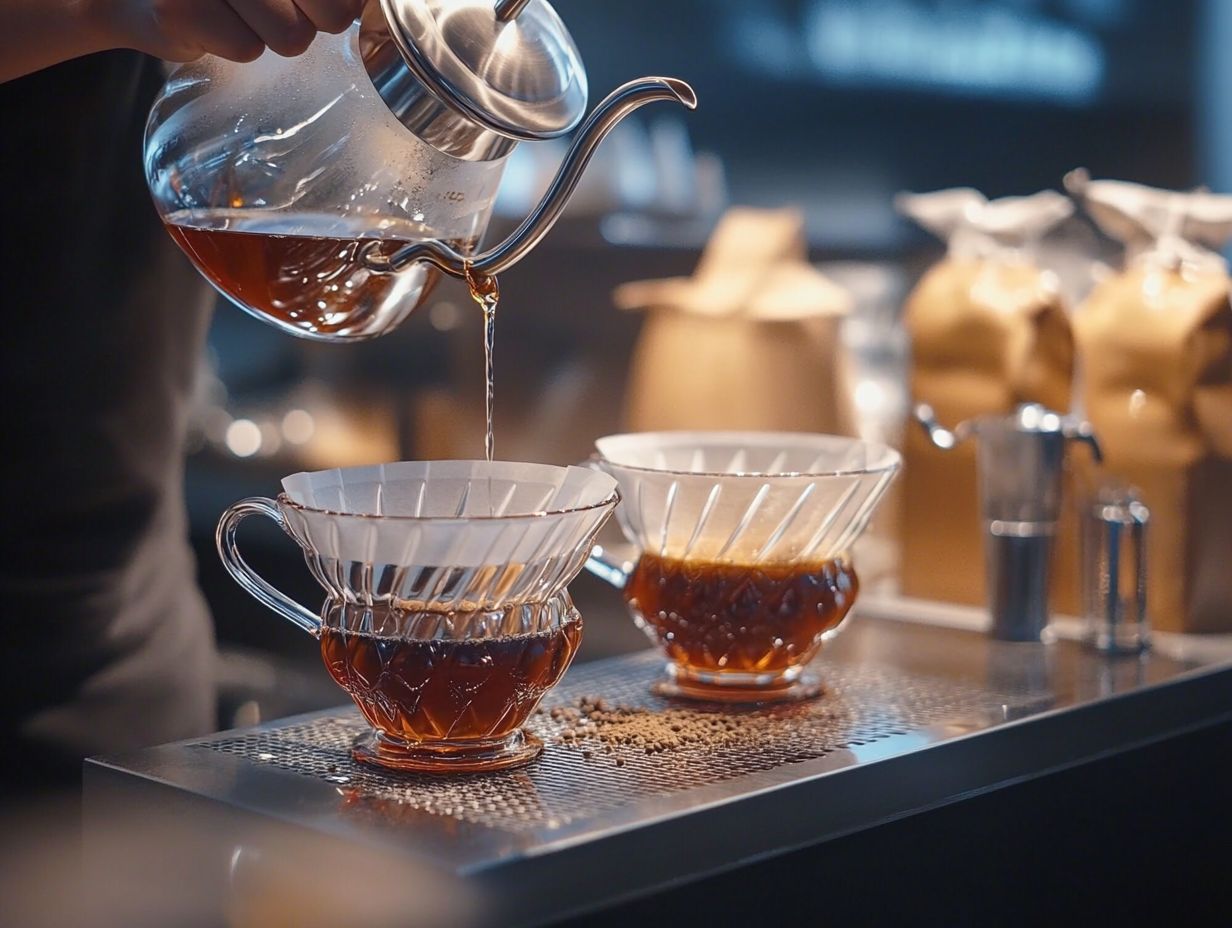
- Proper measurement of coffee and water is crucial for a balanced and flavorful cup of specialty coffee, using tools like coffee scales.
- The right grind size is essential for achieving the desired strength and flavor in your coffee, whether using a Fellow Ode Coffee Grinder or a Breville Barista Pro.
- Water temperature plays a critical role in extracting the best flavors from your coffee beans, impacting the brewing process significantly.
1. Properly Measuring Coffee and Water
Measuring coffee and water with precision is essential for crafting the perfect coffee experience that coffee lovers appreciate. Those exact measurements can profoundly influence the flavor clarity and overall quality of your brew.
Whether you re indulging in specialty coffee beans or sticking to your everyday blend, consistency in your brewing process is key to improving the taste of your coffee.
Understanding the right brew ratios helps you embark on a delightful coffee journey, exploring various flavor profiles and aromas through different brewing methods. Each cup becomes a unique experience.
Investing in a coffee scale allows you to achieve consistent results with every brew critical for those who truly appreciate the subtleties in flavors and textures. A standard coffee-to-water ratio is typically 1:15 for pour-over, while espresso usually calls for a tighter 1:2 ratio.
By playing around with these ratios, you can customize the strength of your brew to perfectly match your palate. Brewing methods like the French press thrive on a coarser grind and a longer steep time, generally around a 1:12 ratio.
Remember, even minor variations in your coffee or water amounts can dramatically impact extraction, the process of pulling flavors out of coffee grounds into water, leading to either a lackluster or overly bitter brew.
Crafting coffee is a journey filled with precision and passion! Consider keeping a diary of your brewing experiments to track what best suits your taste.
2. Choosing the Right Grind Size
Choosing the right grind size is crucial for unlocking the full flavor potential of your coffee, ensuring high coffee quality. Different brewing methods demand specific grind sizes to achieve optimal extraction and taste.
For instance, a fine grind is perfect for espresso, while a coarser grind is the way to go for French press and cold brew. By understanding the relationship between grind size and brewing time, you can elevate your coffee game, enhancing both flavor clarity and aroma.
The grind size not only affects brewing time but also plays a pivotal role in the extraction process, determining how much flavor from the coffee beans is released into the water, making each cup a unique coffee experience.
Take the Fellow Ode Coffee Grinder, for example; it offers precise grind size adjustments, making it an excellent choice for those eager to explore various brewing techniques. On the other hand, when using an espresso machine like the Breville Barista Pro, achieving a fine, consistent grind is vital for crafting a balanced shot with rich crema.
By selecting the right grind size for each brewing method, you ensure that every cup captures the intricate flavors and aromas, ensuring a truly satisfying coffee experience, enriched by diverse coffee varieties.
3. Using the Correct Water Temperature
Using the right water temperature is essential in the brewing process. It directly impacts the extraction of flavors and aromas from your coffee beans.
For the best results, aim for a brewing temperature between 195 F and 205 F (90 C to 96 C). If the water is too hot, you risk over-extraction.
Keeping your equipment clean will help you achieve consistent results. Pay attention to water temperature to enhance your coffee experience.
Understanding how water temperature affects various brewing methods deepens your appreciation for coffee. For example, the pour-over technique thrives on precise temperature control.
In contrast, the French press often benefits from a slightly lower temperature to avoid harsh flavors, creating a fuller body. In terms of espresso, optimal heat is necessary for rapid extraction, delivering bold flavors.
To monitor water temperature effectively, use a reliable thermometer. This ensures each brewing process yields the desired flavor profile.
4. Mastering the Pour-Over Method
Mastering the pour-over method is crucial for you as a coffee enthusiast eager to unlock the full potential of specialty coffee. This precise brewing technique grants you control over water flow, brewing time, and flavor development.
By using devices like the V60 or Chemex, you can create a clean cup that showcases enhanced aroma and flavor clarity. Experimenting with pour rates and brewing times allows you to personalize your pour-over experience and connect with the vibrant coffee community passionate about specialty brews.
To get started, choose high-quality coffee beans, ideally ground to a medium-coarse consistency. This balance ensures proper extraction without tipping into bitter territory.
Heat your water to around 200 F for optimal extraction this is where the magic happens. A general brewing ratio of 1:15 (one part coffee to fifteen parts water) serves as a solid guideline, but feel free to adjust it to suit your taste preferences.
The selection of your pour-over device plays a significant role in shaping the final flavor. Different shapes and materials will influence how the brew interacts with water, so choose wisely.
Don t shy away from experimenting with your pouring technique; whether you go slow and steady or opt for quick bursts can lead to entirely different flavor profiles. The beauty of pour-over coffee lies in this experimentation, inviting you to make unique adaptations that truly resonate with your individual preferences.
5. Understanding the Importance of Bloom
Understanding the importance of bloom in the coffee brewing process is essential for you to maximize flavor extraction and elevate your overall coffee experience. Blooming happens when hot water first touches the coffee grounds, releasing trapped gases and enhancing extraction.
By allowing your coffee to bloom properly, you can unlock a spectrum of flavor notes and aromas, crafting a richer tasting experience that any coffee lover would appreciate. This step is especially vital when using methods like pour-over and AeroPress.
When employing these techniques, the duration of the bloom typically ranging from 30 seconds to a minute can significantly influence the intensity and complexity of your final cup.
A shorter bloom may miss out on some of the nuanced flavors, while a longer bloom promotes greater solvent interaction, leading to richer extractions. If you re experimenting with different coffee types, consider adjusting the bloom time according to grind size; coarser grinds generally benefit from a longer bloom, while finer grinds often yield delightful flavors with a shorter contact time.
Ultimately, mastering the bloom not only enhances your brewing process but also allows you to delve deeper into the intricate profiles of your favorite beans, celebrated by coffee roasters.
6. Perfecting the French Press Technique
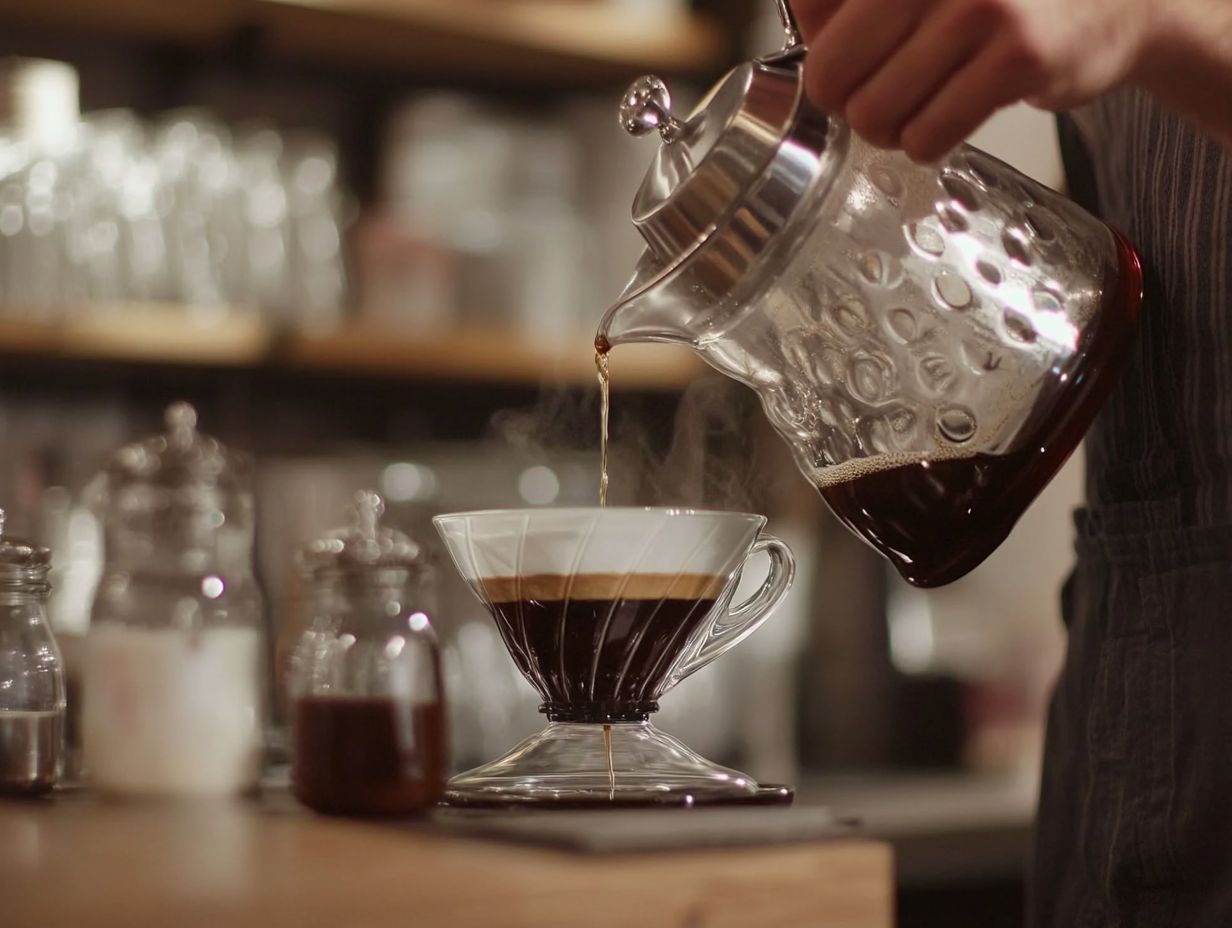
Perfecting your French press technique allows you to craft a full-bodied and robust cup of coffee. This immersion brewing method captures the rich flavors and oils from the coffee grind. Key elements like grind size, steeping time, and water temperature play a crucial role in your brew’s quality.
For optimal flavor clarity, aim for a coarse grind. Let it steep for about 4 to 5 minutes for a truly luxurious coffee experience.
To achieve the best results, measure around two tablespoons of coffee for every six ounces of water. This balanced ratio will elevate your cup. Heat the water to around 200 F just off boiling and remember, excessively hot water can scorch the grounds and introduce unwanted bitterness.
Once the coffee has steeped for the recommended time, gently press the plunger down to separate the grounds from the liquid gold. If you prefer a lighter finish or want to highlight specific flavor notes, adjust the grind size to a slightly finer texture or reduce the brewing time. This simple tweak can lead to delightful variations tailored to your taste.
7. Utilizing the AeroPress for a Stronger Brew
The AeroPress is trending among coffee lovers today for crafting a rich and concentrated cup of coffee. This versatile device mixes soaking and pressing, opening the door to experimentation with various brewing techniques, grind sizes, and coffee-to-water ratios.
With a brewing time of just a few minutes, the AeroPress is ideal for busy coffee aficionados who refuse to compromise on quality. By controlling factors like water temperature, brewing time, and grind consistency, you can significantly influence flavor release and elevate the final flavor profile.
For instance, a finer grind can yield a more intense brew, while a coarser grind produces a lighter cup. Delving into different recipes, like the classic inverted method or the traditional vertical method, can reveal an array of flavors, from fruity and floral to rich and chocolaty.
To achieve optimal extraction, begin with water at around 200 F. Adjust the steeping time and pressure as needed for your personal taste. This journey will help you discover your perfect cup of coffee.
8. Cold Brewing for a Refreshing Cup
Cold brewing is gaining immense popularity among coffee aficionados, delivering a smooth and refreshing cup that beautifully showcases the natural sweetness and complexity of coffee flavors while sidestepping the acidity of traditional hot brewing methods.
Steep coffee grounds in cold water for 12 to 24 hours to create a concentrated coffee extract that can be diluted to your liking. This makes it the perfect choice for warm days or chilled coffee beverages.
Unlike hot brewing, cold brewing results in a mellow, well-rounded cup. The recommended coffee-to-water ratio typically ranges from 1:4 to 1:8, depending on your taste preferences. A coarser grind will yield the best results.
For those seeking enhanced flavor clarity, experiment with different steeping times or rinse the grounds before brewing. This trick often reduces bitterness and elevates the inherent sweetness of certain coffee varieties.
Take Ethiopian Yirgacheffe beans, known for their bright floral and fruity notes, or Costa Rican beans, which offer a balanced flavor profile; both shine brilliantly in a cold brew, making each sip delightful.
Try these techniques today and discover your new favorite cup of coffee!
9. Using the Chemex for a Clean and Balanced Flavor
Using the Chemex brewing method is a remarkable way for you to achieve a clean and balanced cup of coffee. Its unique design and thick filters work wonders in removing oils and sediment, allowing the true flavor profile of specialty coffee beans to shine.
The Chemex elevates both aroma and flavor clarity, making it a top choice for coffee enthusiasts who savor a crisp and bright cup. By carefully mastering the brewing parameters, you’ll unlock a delightful coffee experience.
To get started, select a medium-coarse grind size that resembles sea salt. This will set you up for optimal extraction during brewing. Aim for an ideal water temperature of around 200 F just off the boil to avoid scalding those precious coffee grounds.
When it comes time to pour, a steady, circular motion is your best friend. Start from the center and move outward to evenly saturate the coffee, which helps achieve a more balanced extraction.
If you’re keen on enhancing your brewing skills, don t hesitate to experiment with different brew ratios (the ratio of coffee to water used in brewing) and grind adjustments. These small changes can unlock amazing new flavors and significantly impact the final taste, allowing you to craft a personalized coffee experience tailored to your taste.
10. Experimenting with Different Brewing Methods
Experimenting with different brewing methods is essential to your journey as a coffee lover, allowing you to explore a myriad of flavor profiles and techniques that can elevate your coffee experience. From classic methods like drip coffee and Moka pots to groundbreaking techniques such as siphon brewing and nitro cold brew, each approach offers a unique opportunity to uncover the distinct characteristics of various coffee varieties.
Engaging with the coffee community can provide you with invaluable insights and innovative ideas to enhance your brewing prowess.
By trying out an array of brewing methods, you can unlock subtle nuances in aroma and taste that may have eluded you before. For instance, using a pour-over might highlight the floral notes in a light roast, while an espresso machine can reveal deep, chocolatey flavors that are utterly delightful.
Keep in mind that experimentation doesn’t have to come with a hefty price tag; simple tools can yield exceptional results. Don’t shy away from documenting your brewing adventures and sharing them online your experiences could inspire fellow coffee aficionados.
Participating in this exchange not only enriches your personal journey but also contributes to the vibrant community of coffee lovers that thrives on creativity and passion.
What Is Specialty Coffee and Why Is Brewing Technique Important?
Specialty coffee represents the pinnacle of coffee craftsmanship, sourced from specific regions and celebrated for its unique flavor profiles, careful preparation, and expert brewing techniques.
What truly distinguishes it from commercial coffee is not merely its origin but the extraordinary care involved in every stage of its journey, from cultivation to cup. Specialty coffee showcases distinct characteristics shaped by factors such as altitude and carefully selected varietals, ultimately offering you a more intricate taste experience.
The brewing technique you choose can dramatically transform the flavor and aroma of your final cup. For instance, using a pour-over method allows for precise control over water flow, producing a cleaner taste that accentuates floral notes. In contrast, a French press may deliver a richer, fuller body thanks to its immersion process.
By mastering these particular methods, you can elevate the quality of your specialty coffee, unlocking a spectrum of tasting profiles that tell the unique story of the beans.
Don t wait grab your Chemex and start brewing today for a transformative coffee experience!
What Are the Key Factors in Brewing a Good Cup of Specialty Coffee?
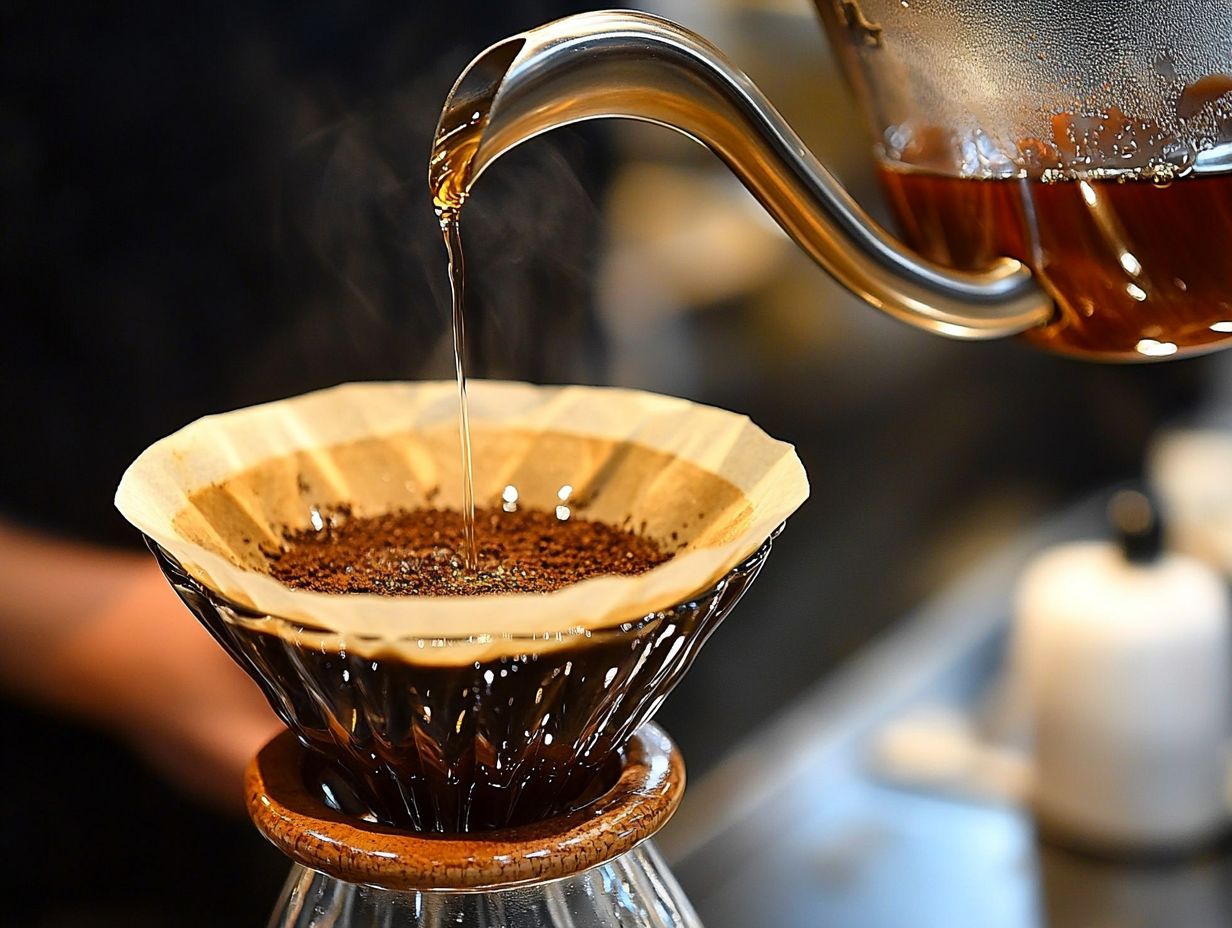
Brewing an exceptional cup of specialty coffee hinges on several key factors, including grind size, water temperature, and brewing time all of which must work in harmony to achieve optimal extraction.
By understanding these elements, you can tailor your brewing process. This highlights the unique flavor notes and aromas of each coffee variety. Mastering these factors can elevate an ordinary cup of coffee into an extraordinary experience.
Take grind size, for instance; selecting the right one is crucial. Grind size refers to how finely or coarsely coffee beans are ground. Finer grounds typically extract more flavor, making them perfect for espresso or Aeropress. Coarser grounds shine in methods like French press or cold brew.
Water temperature is another vital aspect. Hotter water can lead to over-extraction and bitterness. Cooler water might under-extract, leaving you with a weak flavor. The sweet spot for brewing is generally between 195 F to 205 F.
Adjusting your brewing time is also key to achieving balance. Shorter times work well for pour-over methods, while longer steeping is ideal for immersion techniques. By fine-tuning these elements, you can enhance the complexity and richness of your coffee.
This ensures that every cup is a delightful indulgence.
How Can One Determine the Best Brewing Technique for Their Coffee?
Determining the best brewing technique for your coffee requires a deep understanding of your personal preferences and the distinct characteristics of the coffee beans at your disposal.
Each method can significantly influence extraction and flavor clarity. It s essential to consider factors like the taste notes you desire, the brewing equipment you have, and the extraction methods available to you.
By experimenting with various brewing styles, you can uncover which techniques truly enhance the aromas and flavors of your favorite coffee varieties. Dive into different brewing methods such as pour-over, French press, and espresso.
Each technique presents its unique flavor profile and mouthfeel. For example, you might find that a French press delivers a fuller body, while pour-over techniques can accentuate those subtle notes and vibrant brightness.
Don t forget to keep track of your brewing parameters, including water temperature, grind size, and steeping time. These elements can dramatically shape the final cup you savor.
By meticulously fine-tuning these variables, you can achieve the perfect balance of acidity, sweetness, and bitterness. This ultimately leads to a more personalized and satisfying coffee experience.
What Are the Common Mistakes in Brewing Specialty Coffee?
Brewing specialty coffee comes with its own set of unique challenges. It s not uncommon for even the most passionate coffee enthusiasts to stumble into pitfalls that can compromise the flavor and quality of their brew.
Mistakes like using the wrong grind size, miscalculating brew ratios, or neglecting water temperature can lead to undesirable extraction. This results in a lackluster coffee experience.
Recognizing and addressing these issues is essential for honing your skills and unlocking the full potential of specialty coffee. For instance, if you opt for a grind size that s too coarse, you might find yourself facing over-extraction.
This leaves your cup tasting bitter and harsh. On the flip side, a grind that’s too fine could lead to under-extraction, making your coffee taste sour or lacking in depth.
Getting the brew ratio wrong like using too much coffee relative to water can overwhelm your palate. Using too little can result in a weak brew.
Failing to monitor water temperature can sabotage your extraction process altogether. Water that s too hot can scorch your coffee, while water that s not hot enough will leave you underwhelmed.
To navigate these common pitfalls, it would be wise to invest in a good scale for precise measurements. Regularly check your grinder settings and use a thermometer to ensure your water is in the ideal range of 195 F to 205 F.
By paying close attention to these details, you can significantly elevate your brewing experience. Fully savor the rich array of flavors that specialty coffee has to offer.
How Can One Improve Their Brewing Technique?
Improving your brewing technique is a truly rewarding endeavor that can lead to remarkable enhancements in the quality and flavor of your coffee. This enables you to savor the intricate nuances of each cup. By honing in on elements like grind size, brewing methods, and extraction times, you can refine your skills and elevate your coffee experience.
Engaging with the coffee community, sharing insights, and experimenting with various techniques will inspire your growth on this brewing journey.
For instance, adjusting the grind size can dramatically impact flavor. A finer grind typically yields a bolder brew, while a coarser grind can offer a lighter taste. Monitoring water temperature is crucial if it s too hot, you risk over-extracting flavors; if it s too cool, you may end up with underwhelming flavors. Varying your brewing times can unveil different flavor profiles, allowing you to find the taste that perfectly suits your palate.
Local coffee clubs or online forums provide a wealth of resources and support. They foster a shared enthusiasm for the craft and encourage you to push your limits creatively.
What Are the Latest Trends in Specialty Coffee Brewing?
Staying current with the latest trends in specialty coffee brewing can elevate your coffee experience and inspire you to experiment with innovative methods. Whether exploring new brewing devices like the Fellow Ode Coffee Grinder or trying unique techniques such as nitro cold brew, the ever-evolving world of coffee brewing is filled with thrilling opportunities.
Dive into the coffee community to gain valuable insights into emerging trends and best practices for brewing exceptional specialty coffee.
As you discover new gadgets, like precision pour-over kettles or immersion brewers, you’ll unlock flavors in your favorite beans that you never knew existed. Techniques such as cold brew steeped with intriguing flavorings or the careful selection of specific water temperatures can transform an ordinary cup into an extraordinary flavor experience. For more insights, explore brewing techniques for filter coffee.
By exploring these trends, you not only refine your brewing skills but also engage in conversations surrounding sustainability and ethical sourcing critical elements in today s coffee culture.
Visiting local cafes and participating in workshops can further enhance your appreciation for both the craft and the community that make specialty coffee so special.
Frequently Asked Questions
What Should You Keep in Mind When Brewing Specialty Coffee?
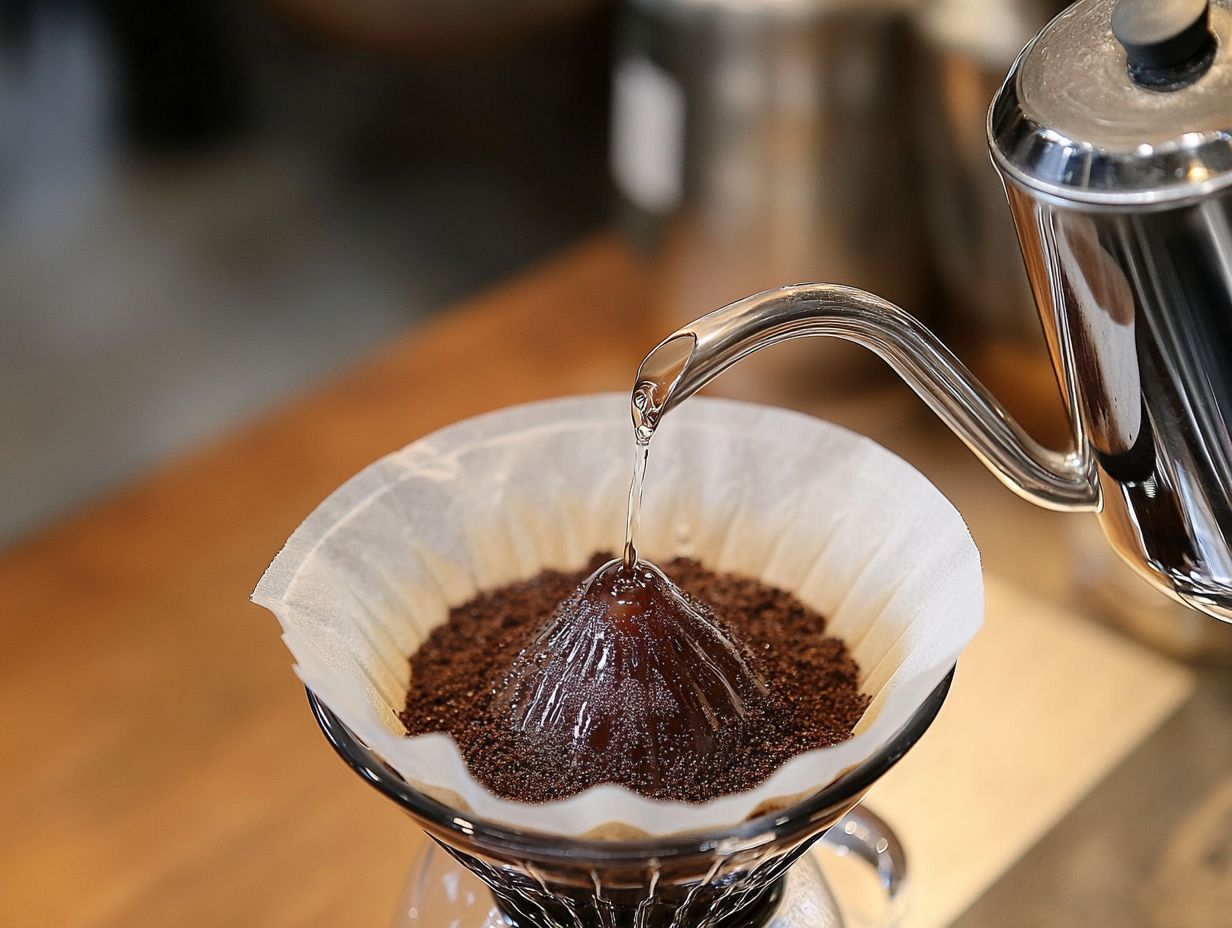
The main factors to consider when brewing specialty coffee are water temperature, coffee grind size, brewing time, coffee-to-water ratio, and water quality.
Why Is Water Temperature Important in Brewing Specialty Coffee?
Water temperature is important in brewing specialty coffee because it affects the extraction of flavors and aromas from the coffee beans. Generally, the recommended temperature is between 195-205 F.
How Does Grind Size Affect the Taste of Specialty Coffee?
The grind size of the coffee beans can greatly impact the taste of the coffee. Finer grinds are used for methods like espresso, while coarser grinds are better for methods like French press. Using the wrong grind size can result in over- or under-extracted coffee, affecting the taste and quality.
What Is the Ideal Coffee-to-Water Ratio for Brewing Specialty Coffee?
The ideal coffee-to-water ratio for brewing specialty coffee is 1:16, meaning 1 gram of coffee for every 16 grams of water. This ratio can be adjusted based on personal preference, but it serves as a solid starting point.
How Can I Improve the Water Quality for Brewing Specialty Coffee?
Improving water quality for brewing specialty coffee can be accomplished by using filtered or bottled water. Tap water may contain minerals and impurities that affect the taste of the coffee. It s also essential to regularly clean and descale your coffee brewing equipment.
Are There Any Specific Brewing Techniques for Different Types of Specialty Coffee?
Yes, there are different brewing techniques that work better for certain types of specialty coffee. For example, pour-over methods are popular for lighter roasts, while immersion methods like French press work well for darker roasts. It is important to experiment and find the best brewing technique for each type of specialty coffee.

